Characteristics, Chemical Speciation and Health Risk Assessment of Heavy Metals in Paddy Soil and Rice around an Abandoned High-Arsenic Coal Mine Area, Southwest China
Abstract
:1. Introduction
2. Materials and Methods
2.1. Study Area and Sampling
2.2. Chemical Analysis
2.3. Ecological Risk of HMs in Soils
2.3.1. Rations of Secondary Phase and Primary Phase
2.3.2. Risk Assessment Code
2.3.3. Accumulation and Transfer Factors
2.3.4. Health Risk Assessment
2.3.5. Statistical Analysis
3. Results
3.1. HM Contents and Physicochemical Parameters in Soil and Rice
3.2. Evaluation of HM Speciation Contents in Soil
3.3. Accumulated and Transfer Factors in Root, Stem, Leaves and Grain of Rice
3.4. Health Risk Assessment of HMs in Soil and Rice
4. Discussion
5. Conclusions
Author Contributions
Funding
Data Availability Statement
Conflicts of Interest
References
- Xu, S.S.; Zhao, Q.H.; Qin, C.Z.; Qin, M.Z.; Lee, J.; Li, C.Y.; Li, Y.Y.; Yang, J.X. Effects of vegetation restoration on accumulation and translocation of heavy metals in post-mining areas. Land Degrad. Dev. 2021, 32, 2000–2012. [Google Scholar] [CrossRef]
- Wu, X.L.; Hu, J.W.; Qi, J.M.; Hou, Y.; Wei, X.H. Graphene-supported ordered mesoporous composites used for environmental remediation: A review. Sep. Purif. Technol. 2020, 239, 116511. [Google Scholar] [CrossRef]
- Raklami, A.; Tahiri, A.I.; Bechtaoui, N. Restoring the plant productivity of heavy metal-contaminated soil using phosphate sludge, marble waste, and beneficial microorganisms. J. Environ. Sci. 2021, 99, 210–221. [Google Scholar] [CrossRef]
- Hoang, H.G.; Chiang, C.F.; Lin, C. Human Health Risk Simulation and Assessment of Heavy Metal Contamination in a River Affected by Industrial Activities. Environ. Pollut. 2021, 285, 117414. [Google Scholar] [CrossRef]
- Haghnazar, H.; Belmont, P.; Johannesson, K.H. Human-induced pollution and toxicity of river sediment by potentially toxic elements (PTEs) and accumulation in a paddy soil-rice system: A comprehensive watershed-scale assessment. Chemosphere 2023, 311, 136842. [Google Scholar] [CrossRef] [PubMed]
- Sarkar, R.D.; Zhang, Z.; Warke, M.; Datta, R. Health Risk from Toxic Metals in Wild Rice Grown in Copper Mining-Impacted Sediments. Appl. Sci. 2022, 12, 2937. [Google Scholar] [CrossRef]
- Anwarul Hasan, G.M.M.; Das, A.K.; Satter, M.A. Accumulation of Heavy Metals in Rice (Oryza sativa L.) Grains Cultivated in Three Major Industrial Areas of Bangladesh. J. Environ. Public Health 2022, 2022, 1836597. [Google Scholar]
- Wu, P.; Peng, T.Q.; Feng, L.J.; Zhu, L.J.; Tao, X.Z.; Zhang, L.D. Investigation on arsenic of surface soils and sediments from the coal area of Xingren country, Guizhou Province. Earth Environ. 2006, 34, 31–35. [Google Scholar]
- Pang, W.P.; Qin, F.X.; Lv, Y.C. Chemical speciations of heavy metals and their risk assessment in agricultural soils in a coalmining area from Xingren County, Guizhou Province. Chin. J. Appl. Ecol. 2016, 27, 1468–1478. [Google Scholar]
- Luo, M.X.J.; Li, P.; Xu, Z.D. Concentrations and Accumulation of Cd, Hg and As in Common Pteridophytes and Their Rhizosphere Soils at an Abandoned Coal Mine in Xingren, Guizhou. Earth Environ. 2019, 47, 629–636. [Google Scholar]
- Li, Z.; Ma, Z.; Kuijp, T. A review of soil heavy metal pollution from mines in China: Pollution and health risk assessment. Sci. Total Environ. 2014, s468–s469, 843–853. [Google Scholar] [CrossRef] [PubMed]
- Xia, P.; Ma, L.; Yi, Y. Assessment of heavy metal pollution and exposure risk for migratory birds-A case study of Caohai wetland in Guizhou Plateau (China). Environ. Pollut. 2021, 275, 116564. [Google Scholar] [CrossRef] [PubMed]
- Khan, R.; Saxena, A.; Shukla, S. Environmental contamination by heavy metals and associated human health risk assessment: A case study of surface water in Gomti River Basin, India. Environ. Sci. Pollut. Res. 2021, 28, 56105–56116. [Google Scholar] [CrossRef] [PubMed]
- Selvam, S.; Jesuraja, K.; Roy, P.D. Human health risk assessment of heavy metal and pathogenic contamination in surface water of the Punnakayal estuary, South India. Chemosphere 2022, 298, 134027. [Google Scholar] [CrossRef]
- Karimian, S.; Shekoohiyan, S.; Moussavi, G. Health and ecological risk assessment and simulation of heavy metal-contaminated soil of Tehran landfill. RSC Adv. 2021, 11, 8080–8095. [Google Scholar] [CrossRef] [PubMed]
- Zhang, Y.; Wang, S.; Gao, Z. Contamination characteristics, source analysis and health risk assessment of heavy metals in the soil in Shi River Basin in China based on high density sampling. Ecotoxicol. Environ. Saf. 2021, 227, 112926. [Google Scholar] [CrossRef] [PubMed]
- Fan, M.Y.; Yang, H.; Huang, X.F.; Cao, R.S. Chemical forms and risk assessment of he avy metals in soils around a typical coal-fired power plant located in the mountainous area. China Environ. Sci. 2016, 36, 2425–2436. [Google Scholar]
- Xin, G.S.; Hu, Z.; Zhou, W.; Yang, Z.Q.; Guo, X.S.; Long, R.J. Determination of inorganic elements in the soil-grass-animal system by sealed microwave digestion ICP-AES. Spectrosc. Spectr. Anal. 2010, 30, 546–550. [Google Scholar]
- Bochove, V.; Eric, B.C.; Suzanne, T.R.G. Continuous multiple measurement of soil redox potential using platinum microelectrodes. Soil Sci. Soc. Am. J. 2002, 66, 1813–1820. [Google Scholar] [CrossRef]
- Carter, B.; Dimarzo, L.; Pranata, J. Determination of the efficiency of removal of whey protein from sweet whey with ceramic microfiltration membranes. J. Dairy Sci. 2021, 104, 7534–7543. [Google Scholar] [CrossRef]
- Tessier, A.; Campbell, P.G.; Bisson, M. Sequential extraction procedure for the speciation of particulate trace metals. Anal. Chem. 1979, 51, 844–851. [Google Scholar] [CrossRef]
- Xie, S.W.; Guo, X.S.; Yang, F.; Huang, Q.; Chen, M.J.; Wei, X.H.; Liu, C.S. Accumulation Characteristics, Geochemical Fractions Distribution and Ecological Risk of Heavy Metals in Soils of Urban Parks in Guangzhou, China. Ecol. Environ. 2022, 31, 2206–2215. [Google Scholar]
- Sun, J.W.; Yu, R.L.; Hu, G.R. Assessment of heavy metal pollution and tracing sources by Pb & Sr isotope in the soil profile of woodland in Quanzhou. Environ. Sci. 2017, 38, 1566–1575. [Google Scholar]
- Jain, C.K. Metal fractionation study on bed sediments of river Yamuna, India. Water Res. 2004, 38, 569–578. [Google Scholar] [CrossRef]
- Chen, Z.; Muhammad, I.; Zhang, Y.; Hu, W.; Lu, Q.; Wang, W.; Huang, B.; Hao, M. Transfer of heavy metals in fruits and vegetables grown in greenhouse cultivation systems and their health risks in Northwest China. Sci. Total Environ. 2021, 766, 142663. [Google Scholar] [CrossRef] [PubMed]
- Wu, J.; Lu, J.; Zhang, C.; Zhang, Y.X.; Lin, Y.C.; Xu, J. Pollution, sources, and risks of heavy metals in coastal waters of China. Hum. Ecol. Risk Assess. Int. J. 2019, 26, 2011–2026. [Google Scholar] [CrossRef]
- United States Environmental Protection Agency (US EPA). Risk Assessment Guidance for Superfund, Vol. I: Human Health Evaluation Manual; Office of Emergency and Remedial Response: Washington, DC, USA, 1989. [Google Scholar]
- Middleton, D.R.S.; Watts, M.J.; Beriro, D.J.; Hamilton, E.M.; Leonardi, G.S.; Fletcher, T.; Close, R.M.; Polya, D.A. Arsenic in residential soil and household dust in Cornwall, south west England: Potential human exposure and the influence of historical mining. Environ. Sci. Process. Impacts 2017, 19, 517–527. [Google Scholar] [CrossRef]
- Huang, C.; Zhang, L.; Meng, J. Characteristics, source apportionment and health risk assessment of heavy metals in urban road dust of the Pearl River Delta, South China. Ecotoxicol. Environ. Saf. 2022, 236, 113490. [Google Scholar] [CrossRef]
- Kumar, P.; Dipti, S.; Kumar, S. Severe contamination of carcinogenic heavy metals and metalloid in agroecosystems and their associated health risk assessment. Environ. Pollut. 2022, 301, 118953. [Google Scholar] [CrossRef]
- Jiang, Y.; Ma, J.; Ruan, X. Compound health risk assessment of cumulative heavy metal exposure: A case study of a village near a battery factory in Henan Province, China. Environ. Sci. Process. Impacts 2020, 22, 1408–1422. [Google Scholar] [CrossRef] [PubMed]
- Zhao, S.; Ni, Z.K.; Huang, D.L.; Zhang, B.T.; Feng, M.L.; Chen, H.W.; Wang, S.R. Evolution of waler quality of poyang lake using WQl method and diving factors identification. Acta Sci. Circumstantiae 2020, 40, 179–187. [Google Scholar]
- Huang, B.; Long, J.; Liao, H.; Liu, L.; Li, J.; Zhang, J.; Li, Y.; Wang, X.; Yang, R. Characteristics of Bacterial Community and Function in Paddy Soil Profile around Antimony Mine and Its Response to Antimony and Arsenic Contamination. Int. J. Environ. Res. Public Health 2019, 16, 4883. [Google Scholar] [CrossRef]
- Giri, S.; Singh, A.K. Human health risk assessment via drinking water pathway due to metal contamination in the groundwater of Subarnarekha River Basin, India. Environ. Monit. Assess. 2015, 187, 63–70. [Google Scholar] [CrossRef] [PubMed]
- Wongsasuluk, P.; Chotpantarat, S.; Siriwong, W. Heavy metal contamination and human health risk assessment in drinking water from shallow groundwater wells in an agricultural area in Ubon Ratchathani province, Thailand. Environ. Geochem. Health 2014, 36, 169–182. [Google Scholar] [CrossRef] [PubMed]
- Keshavarzi, B.; Hassanaghaei, M.; Moore, F. Heavy metal contamination and health risk assessment in three commercial fish species in the Persian Gulf. Mar. Pollut. Bull. 2018, 129, 245–252. [Google Scholar] [CrossRef]
- Khaiwal, R.; Suman, M. Distribution and health risk assessment of arsenic and selected heavy metals in Groundwater of Chandigarh, India. Environ. Pollut. 2019, 250, 820–830. [Google Scholar]
- Cao, S.; Duan, X.; Zhao, X.; Ma, J.; Dong, T.; Huang, N.; Sun, C.; He, B.; Wei, F. Health risks from the exposure of children to As, Se, Pb and other heavy metals near the largest coking plant in China. Sci. Total Environ. 2014, 472, 1001–1009. [Google Scholar] [CrossRef]
- Sawut, R.; Kasim, N.; Maihemuti, B.; Hu, L.; Abliz, A.; Abdujappar, A.; Kurban, M. Pollution characteristics and health risk assessment of heavy metals in the vegetable bases of northwest China. Sci. Total Environ. 2018, 642, 864–878. [Google Scholar] [CrossRef] [PubMed]
- Grzetic, I.; Ghariani, A. Potential health risk assessment for soil heavy metal contamination in the central zone of Belgrade (Serbia). J. Serb. Chem. Soc. 2008, 73, 923–934. [Google Scholar] [CrossRef]
- Gao, Z.; Weng, H.; Guo, H. Unraveling Influences of Nitrogen Cycling on Arsenic Enrichment in Groundwater from the Hetao Basin Using Geochemical and Multi-isotopic Approaches. J. Hydrol. 2021, 595, 125981. [Google Scholar] [CrossRef]
- Tao, X.Z. The Natural Purification Mechanism of Arsenic in the Water Environment of Xingren High Arsenic Coal Mine Area. Master’s Thesis, Guizhou University, Guiyang, China, 2008; pp. 27–29. [Google Scholar]
- Xie, H. Geological characteristics and distribution types of high-arsenic coal in southwest Guizhou. China Coal 2007, 33, 4–7. [Google Scholar]
- Wang, P.; Zhao, F.J. The transfer and control of cadmium in the soil-rice systems. J. Nanjing Agric. Univ. 2022, 45, 990–1000. [Google Scholar]
- Xiao, X.Y.; Chen, T.B.; Liao, X.Y. Comparison of concentrations and bioconcentration factors of arsenic in vegetables, grain and oil erops in China. Acta Sci. Circumstantiae 2009, 29, 291–296. [Google Scholar]
- Chen, Y.F.; Xu, J.R.; Duan, X.L.; Cao, S.Z.; Sun, S.W.; Kang, Y.J. Health risks of cumulative oral exposure to heavy metals for children living around a coking enterprise. China Environ. Sci. 2019, 39, 4865–4874. [Google Scholar]
- Xia, Z.H.; Duan, X.L.; Qiu, W.X.; Liu, D.; Wang, B.; Shu, T.; Jiang, Q.J.; Lu, B.; Song, Y.X.; Hu, X.X. Health risk assessment on dietary exposure to polycyclic aromatic hydrocarbons (PAHs) in Taiyuan, China. Sci. Total Environ. 2010, 408, 5331–5337. [Google Scholar] [CrossRef]
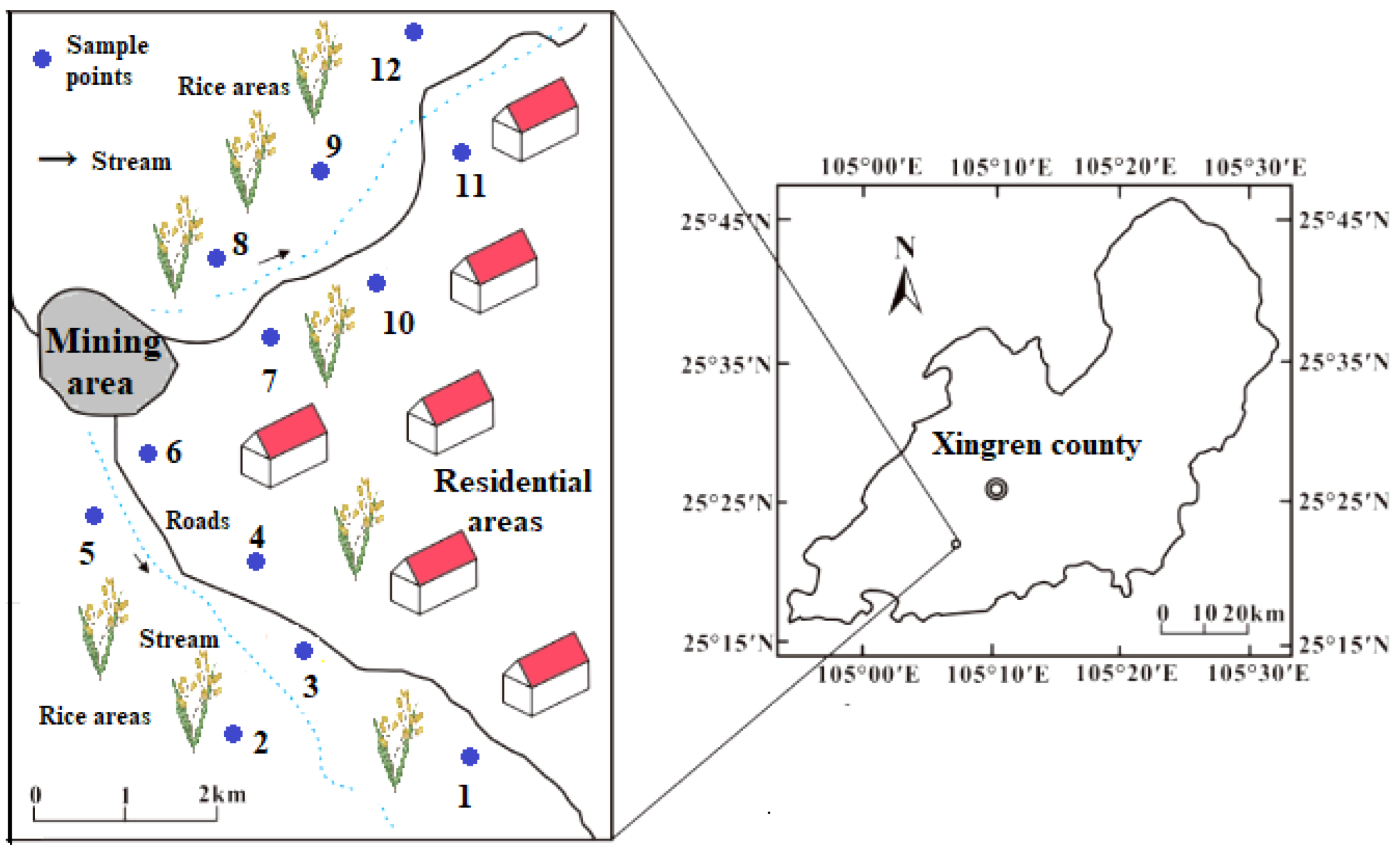
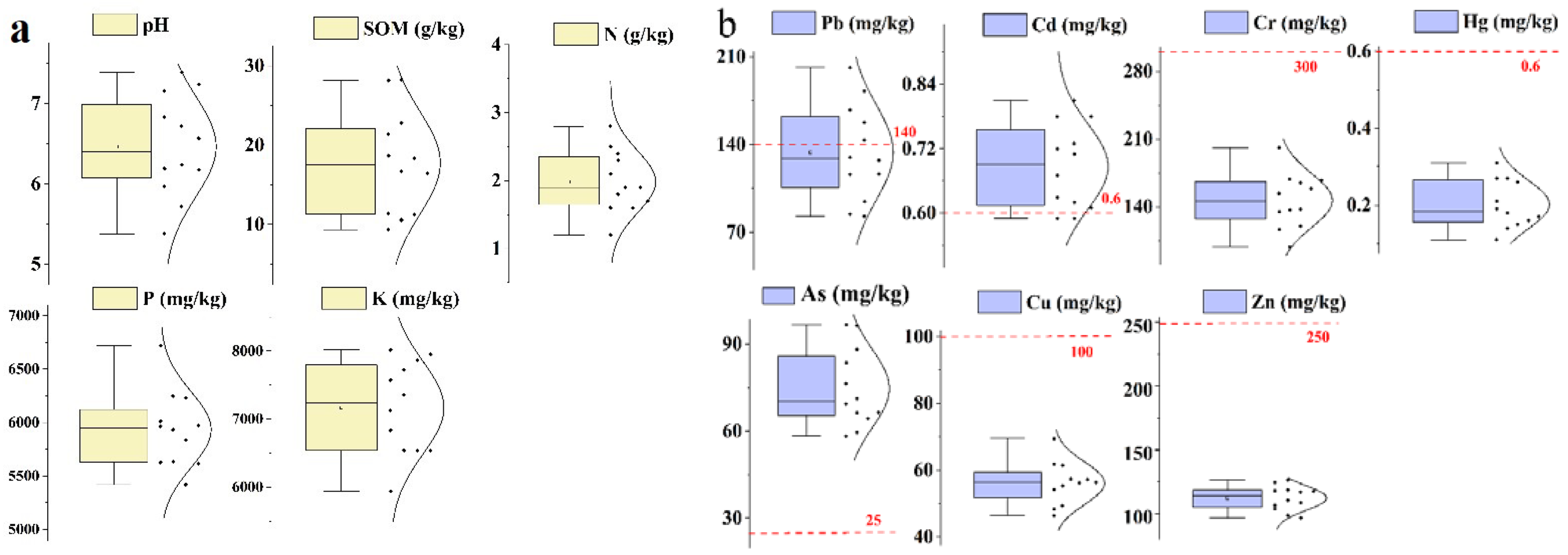
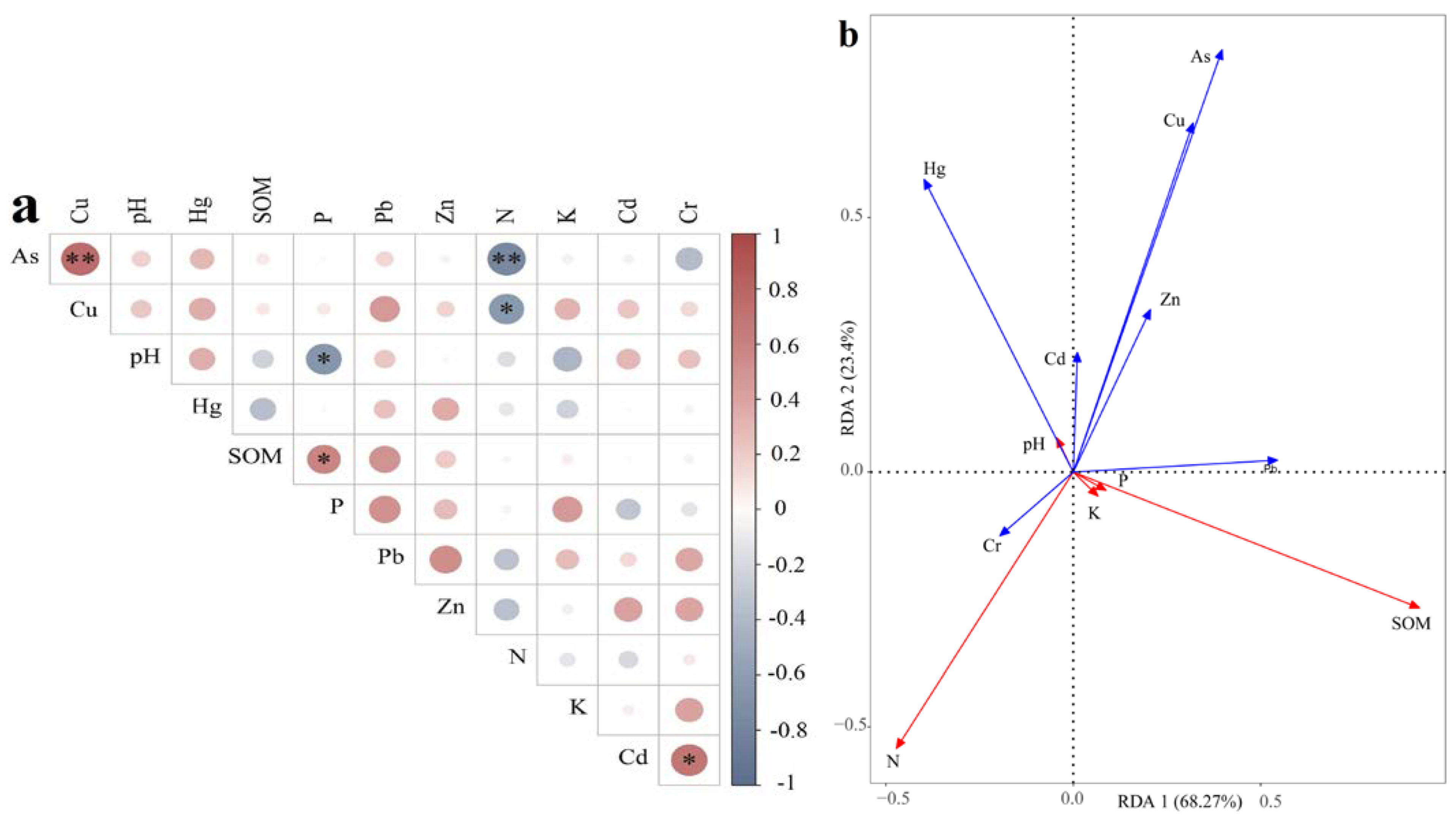
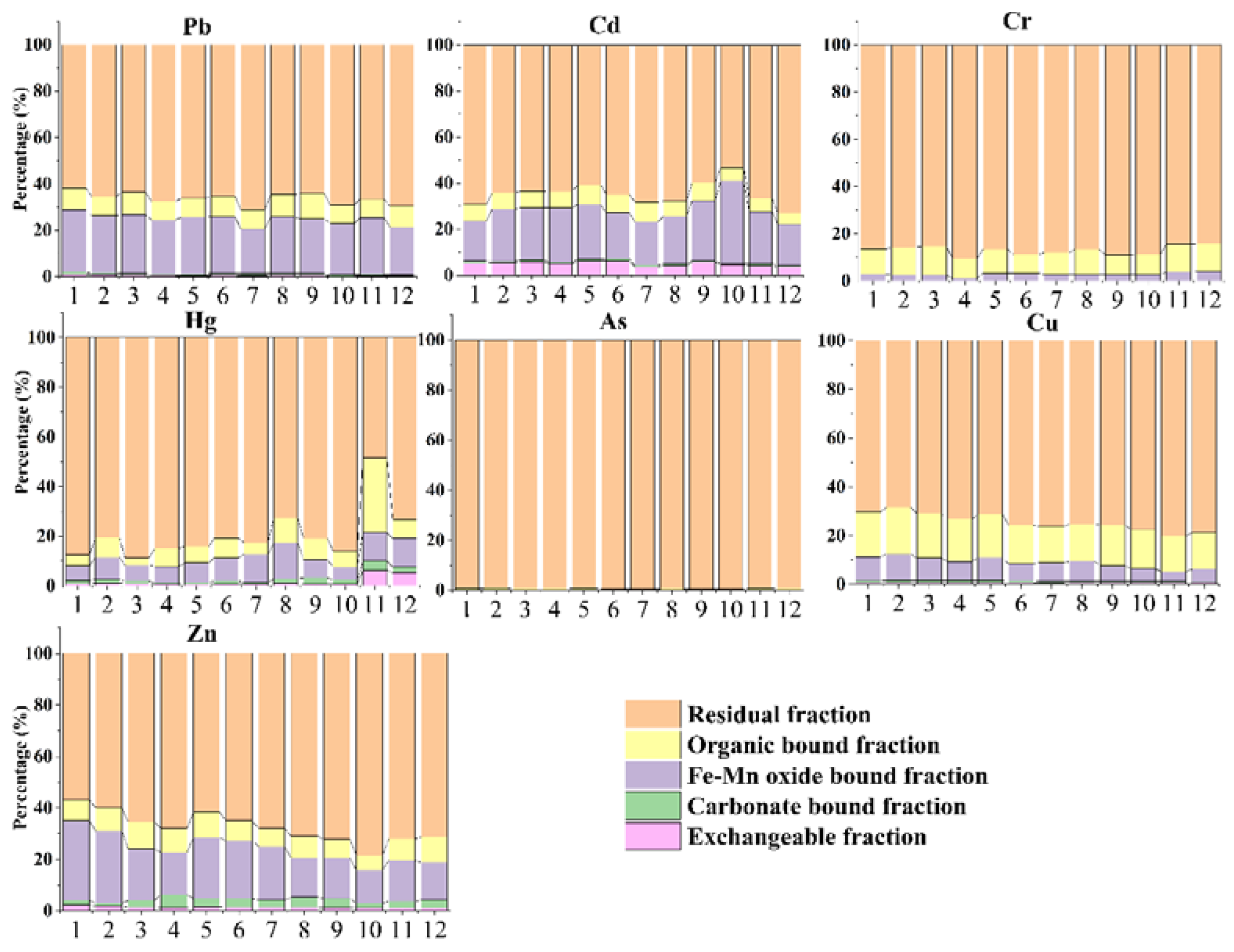
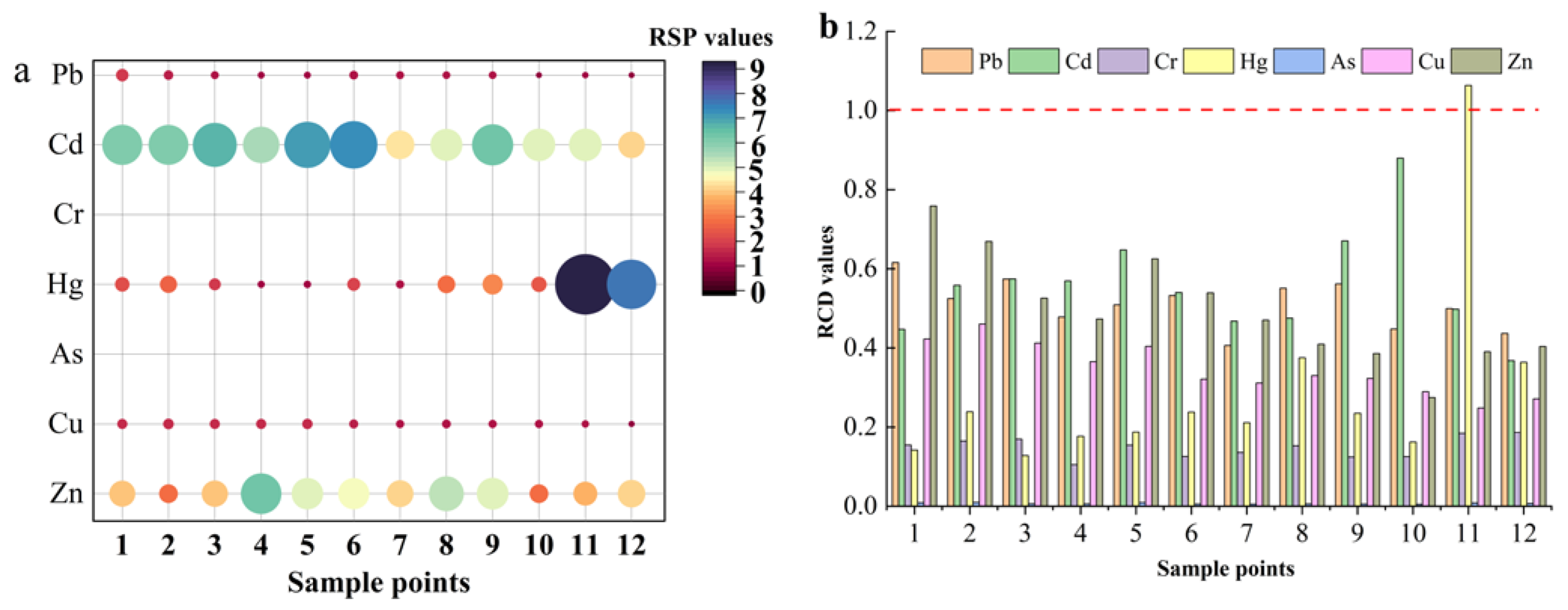
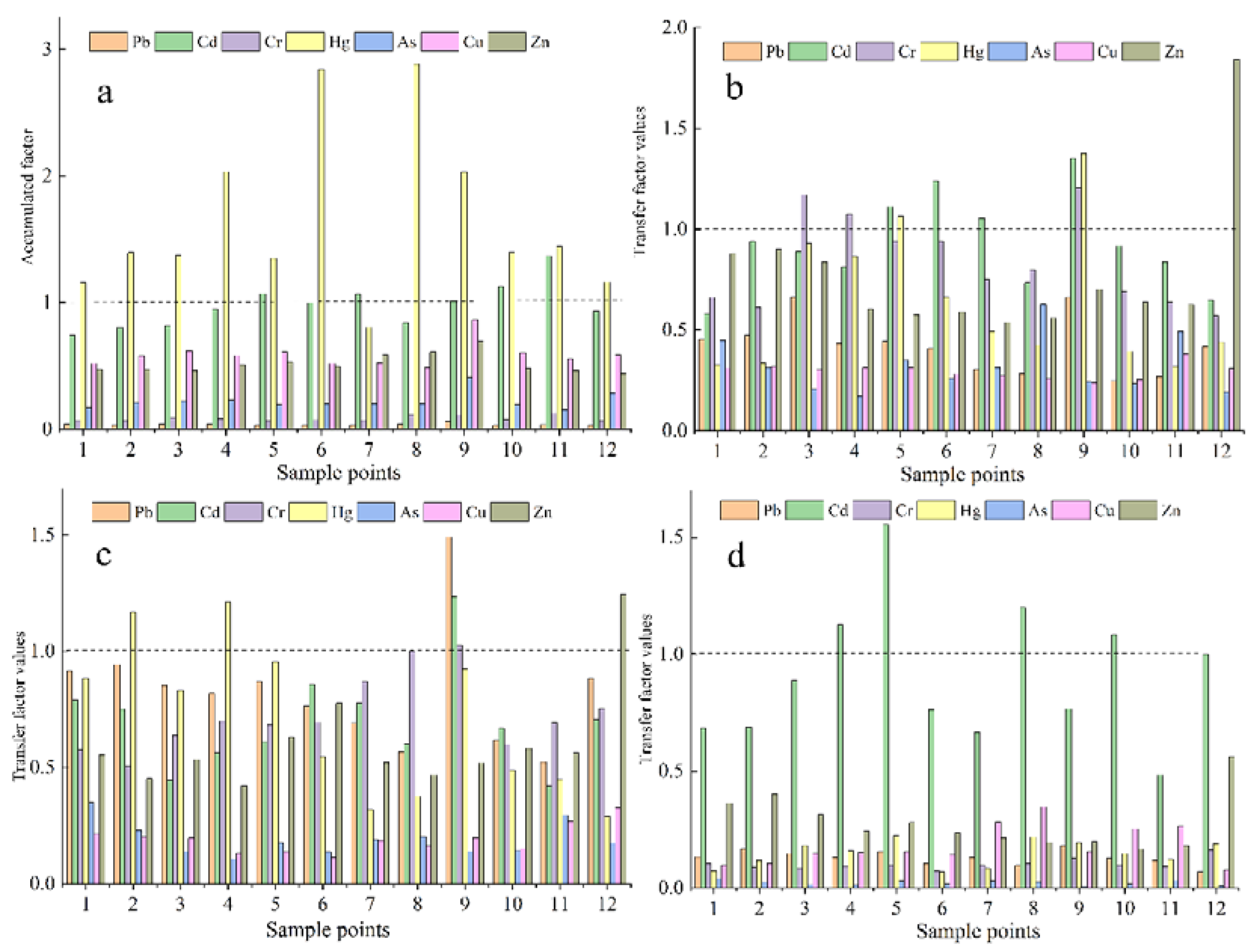
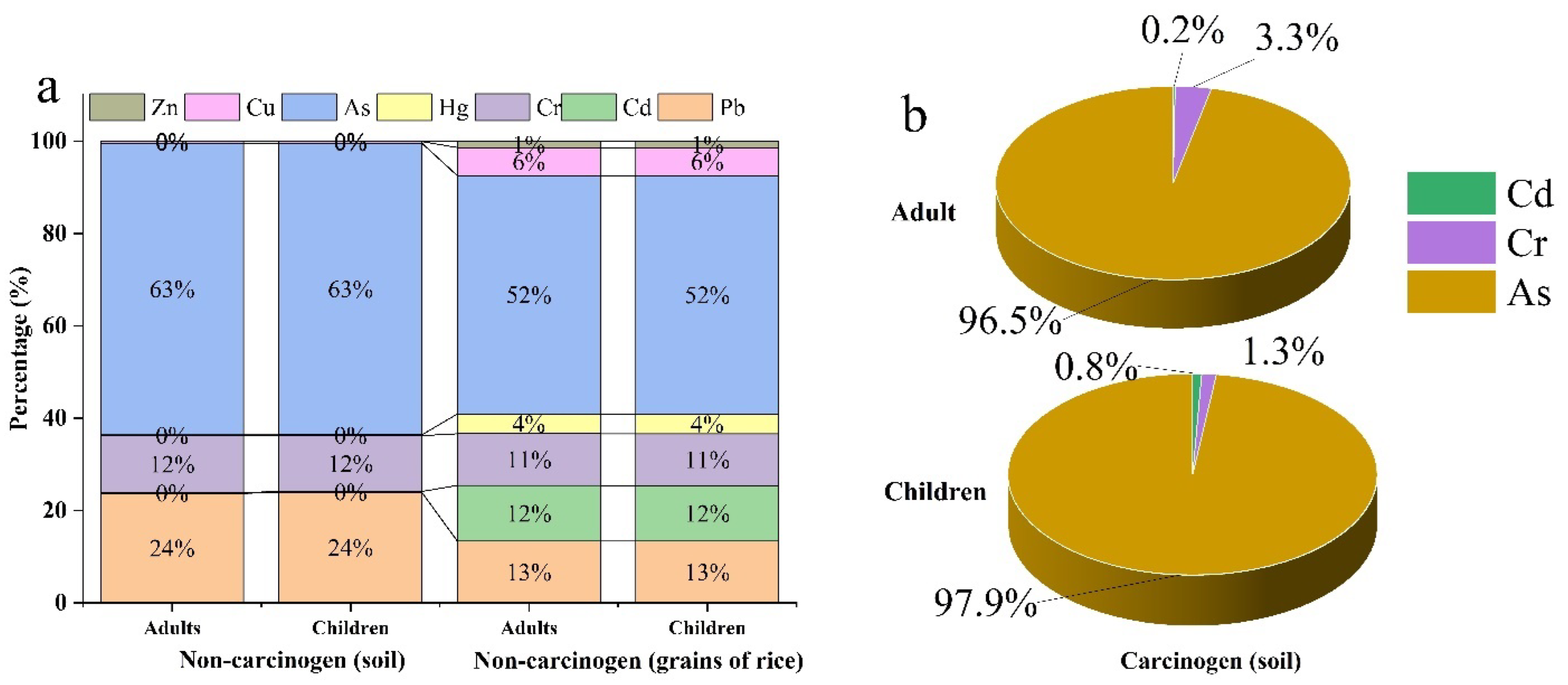
| Parameter | Description | Value |
|---|---|---|
| CW | HMs concentration (mg/kg) | Value from present study |
| IR (rice) | Ingestion rate (g/d) | 420 (Adult) and 150 (Children) |
| IngR (soil) | Soil ingestion rate(g/d) | 0.1 (Adult) and 0.2 (Children) |
| EF | Exposure frequency | 365 days/year |
| ED (noncarcinogenic) | Exposure duration (a) | 30 (Adult) and 6 (Children) |
| ED (carcinogenic) | Exposure duration (a) | 70 (Adult) and 70 (Children) |
| BW | Body weight (kg) | 70 kg (Adult) and 15 kg (Children) |
| AT (noncarcinogenic) | Averaging time in years | ED × 365 (Adult), ED × 365 (Children) |
| AT (carcinogenic) | Averaging time in years | 25,550 (Adult and Children) |
| SA | Exposed skin area (cm2) | 5700 (Adult) and 2800 (Children) |
| PEF | Dust emission factor (m3/kg) | 1.36 × 109 (Adult and Children) |
| CF | Unit conversion factor (kg/mg) | 1 × 10−6 (Adult and Children) |
| SL | Adhesion factor (mg/(cm2·d)) | 0.07 (Adult) and 0.02 (Children) |
| ABS | Dermal absorption fraction | 0.001 (Other metals, adult and children) 0.03 (As, adult and children) |
| RfD Ingestion (mg/kg/day) | Reference dose | 0.0014 (Pb); Cr (0.003); Cd (0.001); Cu (0.04); Zn (0.3); As (0.0003); Hg (0.0003) |
| RfD Dermal (mg/kg/day) | Reference dose | 0.0014 (Pb); 0.000075 (Cr); 0.000025 (Cd); 0.04 (Cu); 0.06 (Zn); 0.0003 (As); 0.000024 (Hg) |
| RfD Inhalation (mg/kg/day) | Reference dose | 0.0014 (Pb); 0.0000286 (Cr); 0.0000571 (Cd); 0.04 (Cu); 0.3 (Zn); 0.0003 (As); 0.0003 (Hg) |
| SF Ingestion (mg/kg/day) | Slope factor | 0.501 (Cr), 6.1 (Cd) and 1.5 (As) |
| SF Dermal (mg/kg/day) | Slope factor | 2.0 (Cr), 24.4 (Cd) and 1.55 (As) |
| SF Inhalation (mg/kg/day) | Slope factor | 42 (Cr), 6.3 (Cd) and 15.1 (As) |
| InhR | Inhalation rate (m3/d) | 20 (Adult) and 10 (Children) |
| Exposure Pathways | Population | HQ Values | HI | ||||||
|---|---|---|---|---|---|---|---|---|---|
| Pb | Cd | Cr | Hg | As | Cu | Zn | |||
| Inhalation (Soil) | Adults (Mean ± SD) | 9.92 × 10−6 ± 2.71 × 10−6 a | 1.25 × 10−6 ± 1.38 × 10−7 a | 5.16 × 10−4 ± 1.15 × 10−4 a | 6.99 × 10−8 ± 2.07 × 10−8 a | 2.59 × 10−5 ± 4.47 × 10−6 a | 1.46 × 10−7 ± 1.59 × 10−8 a | 3.88 × 10−8 ± 3.20 × 10−9 a | 1.11 × 10−3 ± 2.44 × 10−4 a |
| Children (Mean ± SD) | 4.68 × 10−5 ± 1.28 × 10−5 b | 5.89 × 10−6 ± 6.49 × 10−7 b | 2.44 × 10−3 ± 5.43 × 10−4 b | 3.30 × 10−7 ± 9.75 × 10−8 b | 1.22 × 10−4 ± 2.11 × 10−5 b | 6.87 × 10−7 ± 7.48 × 10−8 b | 1.83 × 10−7 ± 1.51 × 10−8 b | 5.23 × 10−3 ± 1.15 × 10−3 b | |
| Dermal contact (Soil) | Adults (Mean ± SD) | 5.38 × 10−5 ± 1.47 × 10−5 a | 1.55 × 10−5 ± 1.71 × 10−6 a | 1.07 × 10−3 ± 2.38 × 10−4 a | 4.74 × 10−6 ± 1.40 × 10−6 a | 4.21 × 10−3 ± 7.28 × 10−4 a | 7.91 × 10−7 ± 8.60 × 10−8 a | 1.05 × 10−6 ± 8.68 × 10−8 a | 1.07 × 10−2 ± 1.97 × 10−3 a |
| Children (Mean ± SD) | 3.56 × 10−4 ± 9.75 × 10−5 b | 1.03 × 10−4 ± 1.13 × 10−5 b | 7.07 × 10−3 ± 1.58 × 10−3 b | 3.14 × 10−5 ± 9.29 × 10−6 b | 2.79 × 10−2 ± 4.82 × 10−3 b | 5.23 × 10−6 ± 5.69 × 10−7 b | 6.97 × 10−6 ± 5.75 × 10−7 b | 7.10 × 10−2 ± 1.30 × 10−2 b | |
| Sum | Adults (Mean ± SD) | 6.37 × 10−5 ± 1.74 × 10−5 a | 1.68 × 10−5 ± 1.85 × 10−6 a | 1.59 × 10−3 ± 3.53 × 10−4 a | 4.81 × 10−6 ± 1.42 × 10−6 a | 4.24 × 10−3 ± 7.32 × 10−4 a | 9.37 × 10−7 ± 1.02 × 10−7 a | 1.09 × 10−6 ± 9.00 × 10−8 a | 1.18 × 10−2 ± 2.21 × 10−3 a |
| Children (Mean ± SD) | 4.03 × 10−4 ± 1.10 × 10−4 b | 1.09 × 10−4 ± 1.19 × 10−5 b | 9.51 × 10−3 ± 2.12 × 10−3 b | 3.17 × 10−5 ± 9.39 × 10−6 b | 2.80 × 10−2 ± 4.84 × 10−3 b | 5.92 × 10−6 ± 6.44 × 10−7 b | 7.15 × 10−6 ± 5.90 × 10−7 b | 7.62 × 10−2 ± 1.42 × 10−2 b | |
| Ingestion (Rice) | Adults (Mean ± SD) | 5.53 × 10−1 ± 1.55 × 10−1 a | 5.02 × 10−1 ± 1.49 × 10−1 a | 4.64 × 10−1 ± 1.19 × 10−1 a | 1.79 × 10−1 ± 6.72 × 10−2 a | 2.14 × 10+0 ± 6.52 × 10−1 a | 2.53 × 10−1 ± 8.61 × 10−2 a | 5.81 × 10−2 ± 1.05 × 10−2 a | 4.15 × 10+0 ± 7.08 × 10−1 a |
| Children (Mean ± SD) | 1.86 × 10+0 ± 5.24 × 10−1 b | 1.69 × 10+0 ± 5.02 × 10−1 b | 1.56 × 10+0 ± 4.01 × 10−1 b | 6.03 × 10−1 ± 2.26 × 10−1 b | 7.22 × 10+0 ± 2.20 × 10+0 b | 8.53 × 10+0 ± 2.90 × 10+0 b | 1.96 × 10−1 ± 3.55 × 10−2 b | 2.17 × 10+1 ± 3.76 × 10+0 b | |
| Exposure Methods | Population | CF Values | TCF Values | ||
|---|---|---|---|---|---|
| Cd | Cr | As | |||
| Hand–mouth | Adults (Mean ± SD) | 2.96 × 10−6 ± 3.26 × 10−7 a | 5.03 × 10−5 ± 1.12 × 10−5 a | 1.49 × 10−3 ± 2.58 × 10−4 a | 1.55 × 10−3 ± 2.70 × 10−4 a |
| Children (Mean ± SD) | 1.81 × 10−5 ± 1.99 × 10−6 b | 2.52 × 10−5 ± 5.62 × 10−6 b | 2.24 × 10−3 ± 3.87 × 10−4 b | 2.28 × 10−3 ± 3.95 × 10−4 b | |
| Inhalation | Adults (Mean ± SD) | 4.50 × 10−10 ± 4.95 × 10−11 a | 6.20 × 10−7 ± 1.38 × 10−7 a | 1.17 × 10−7 ± 2.02 × 10−8 a | 7.38 × 10−7 ± 1.59 × 10−7 a |
| Children (Mean ± SD) | 2.12 × 10−9 ± 2.34 × 10−10 b | 2.93 × 10−6 ± 6.52 × 10−7 b | 5.53 × 10−7 ± 9.55 × 10−8 b | 3.48 × 10−6 ± 7.48 × 10−7 b | |
| Dermal contact | Adults (Mean ± SD) | 9.45 × 10−9 ± 1.04 × 10−9 a | 1.60 × 10−7 ± 3.57 × 10−8 a | 1.96 × 10−6 ± 3.38 × 10−7 a | 2.13 × 10−6 ± 3.75 × 10−7 a |
| Children (Mean ± SD) | 6.26 × 10−8 ± 6.89 × 10−9 b | 1.06 × 10−6 ± 2.36 × 10−7 b | 1.30 × 10−5 ± 2.24 × 10−6 b | 1.41 × 10−5 ± 2.48 × 10−6 b | |
| Sum | Adults (Mean ± SD) | 2.97 × 10−6 ± 3.27 × 10−7 a | 5.11 × 10−5 ± 1.14 × 10−5 a | 1.50 × 10−3 ± 2.58 × 10−4 a | 1.55 × 10−3 ± 2.70 × 10−4 a |
| Children (Mean ± SD) | 1.81 × 10−5 ± 2.00 × 10−6 b | 2.92 × 10−5 ± 6.50 × 10−6 b | 2.25 × 10−3 ± 3.89 × 10−4 b | 2.30 × 10−3 ± 3.98 × 10−4 b |
Disclaimer/Publisher’s Note: The statements, opinions and data contained in all publications are solely those of the individual author(s) and contributor(s) and not of MDPI and/or the editor(s). MDPI and/or the editor(s) disclaim responsibility for any injury to people or property resulting from any ideas, methods, instructions or products referred to in the content. |
© 2023 by the authors. Licensee MDPI, Basel, Switzerland. This article is an open access article distributed under the terms and conditions of the Creative Commons Attribution (CC BY) license (https://creativecommons.org/licenses/by/4.0/).
Share and Cite
Liu, H.; Xie, J.; Cheng, Z.; Wu, X. Characteristics, Chemical Speciation and Health Risk Assessment of Heavy Metals in Paddy Soil and Rice around an Abandoned High-Arsenic Coal Mine Area, Southwest China. Minerals 2023, 13, 629. https://doi.org/10.3390/min13050629
Liu H, Xie J, Cheng Z, Wu X. Characteristics, Chemical Speciation and Health Risk Assessment of Heavy Metals in Paddy Soil and Rice around an Abandoned High-Arsenic Coal Mine Area, Southwest China. Minerals. 2023; 13(5):629. https://doi.org/10.3390/min13050629
Chicago/Turabian StyleLiu, Huijuan, Jiao Xie, Zhifei Cheng, and Xianliang Wu. 2023. "Characteristics, Chemical Speciation and Health Risk Assessment of Heavy Metals in Paddy Soil and Rice around an Abandoned High-Arsenic Coal Mine Area, Southwest China" Minerals 13, no. 5: 629. https://doi.org/10.3390/min13050629




